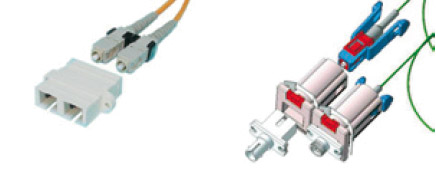Multimode/Singlemode - Optical fibre cables for RME MADI systems
All RME MADI products provide optical I/O for the use with "multimode fibres". "Singlemode" is available on request for all units and allows an operation within existing singlemode networks, without additional expensive converters.
Why glass fibre optics?
The need for huge data transmissions is constantly growing. In the near future traditional twisted-pair copper cables will not meet the requirements of ethernet networks. With Gigabit or 10 Gigabit, traditional cables reach the physical limits. Only optical glass fibres will meet future transmission demands.
Basics
Multimode optical fibres (MADI standard) consist of a core, a cladding and a primary coating. The light-transmitting cable core is made of fibres of glass, and carries the actual signal. The coating totally reflects the light and thus conducts it within the core. The coating is a protective layer against mechanical damage and is usually between 150 and 500 µm in thickness. Between the cladding and the coating, there is a fine layer of lacquer (2 to 5 µm) to keep out moisture. The coating is usually made of soft plastic, but special versions with extremely stable coatings are also available. By now, optical cables can be manufactured cheaper than copper based cables.
A singlemode fibre is a glass fibre with reduced diameter.
Technologies (example: multimode fibre)

- Diameter core: 50 µm or 62.5 µm
- Diameter wrap glass: 125 µm
- Outside diameter: 4 - 9 mm
- Label: 50/125 (orange) or 62.5/125 (blue)
- Transmission format: Multimode
- Max. transmission width: 2000m
Connectors
Like most other MADI devices, the RME MADI products use the common SC-Plug (IEC 874-19) for optical connection. The SC connector is compact and ensures a reproducible and constant connection quality. The SC duplex version combines two fibres. An automatic interlock prevents accidental interruption of the connection. The fibre type, explicitly required for optical MADI connections, must be a 50/125 µm or 62.5/125 µm multi-mode fibre (MM fibre).

Advantages of Optical Fibre compared to Copper Cable
- Insensitive to electromagnetic disturbance
- Optical cables can be run parallel to power cables etc.
- No crosstalk, hum or potential differences
- No influence on audio quality also in long distance applications
- Considerably less weight
Optical fibres have become a new standard. Many manufacturers offer cables and connectors, and even complete road-ready systems with cable drums, with up to 2000m in total length. Please ask your RME dealer for the supporting product line of cables from Alva Cableware (RME approved digital audio cables).
MADI Multinorm
RME supports the following MADI formats/modes:
| Type | Channels | Resolution | Sample frequency | Frame Rate Word Clock | Hints |
|---|---|---|---|---|---|
| Standard 1 | 56 | 24 | 48 | 48 | with ±12.5% Varispeed |
| Standard 2 | 64 | 24 | 48 | 48 | without Varispeed |
| Double Wire 96/48k Mode | 32 | 24 | 96 | 48 | with sample frequency doubled the channel data will be split on two channels - ADAT > S/MUX - Tascam > Dual Line |
| Quad Wire 192/48k Modus | 16 | 24 | 192 | 48 | with sample frequency quadrupled the channel data will be split on four channels - ADAT > S/MUX4 |
| 96k Frame | 32 | 24 | 96 | 96 | alternate transmission mode with Double Speed |

